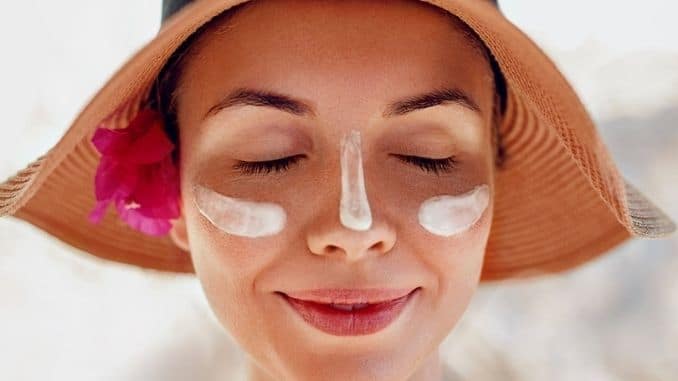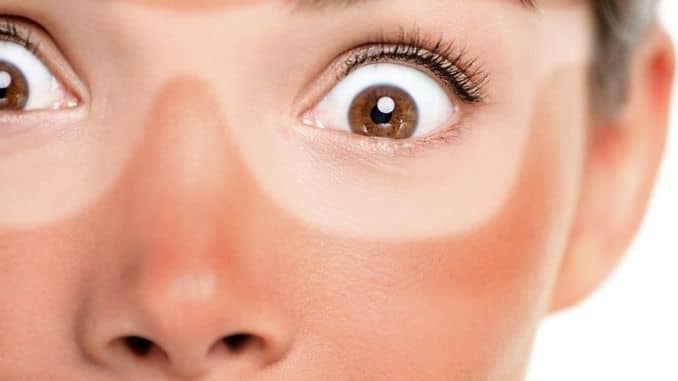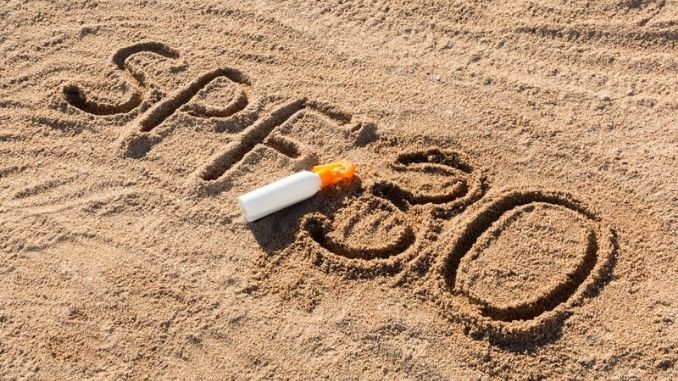
Researchers are finding that sun exposure has more health benefits than just boosting our vitamin D levels. A study out of the University of California has shown that sun exposure can reduce the risk of colon cancer. The Journal of the American Medical Association published a study finding that sun exposure can reduce symptoms associated with Alzheimer’s disease. Research has also found that spending time in the sun can lower your blood pressure, improve brain functioning, enhance the immune system and ease depression.
With all the benefits of a day in the sun, the fact remains that too much sun exposure is the leading cause of skin cancer. So, how can we get the benefits of the sun and still protect our skin from the damaging effects of ultraviolet radiation? The answer is sunscreen. However, many of the ingredients in sunscreen are particularly harmful.
According to the Environmental Working Group (EWG), “The United States Food and Drug Administration [FDA] has not reviewed the evidence of potential hazards of sunscreen filters ― instead it grandfathered in ingredients used in the late 1970s when it began to consider sunscreen safety.” Because we can’t rely on the government to rub the good stuff on our shoulders at the beach, we’ve got to take the time and sort out the safe sunscreen ingredients from the harmful ones.
We’ve reviewed some of the most common active ingredients in the leading brands of sunscreen. We found some sunscreen additives that you should avoid. We also found some safe and effective ingredients that will protect your skin from sunburn.
The Good
Here are some safe active ingredients to look for in a sunscreen. These components will not only protect your skin from ultraviolet (UV) radiation but, to date, they haven’t been linked to any significant health risks.
Titanium Dioxide
Titanium dioxide is a naturally occurring mineral substance used in sunscreens. It is excellent for absorbing and blocking UV rays from the sun. The EWG reports that there is no evidence of titanium dioxide causing hormone disruption or being absorbed into the skin via a traditional application.
Zinc Oxide
Zinc oxide is made from an elemental metal. Zinc is naturally occurring, but zinc oxide is created by chemically heating zinc, combining it with oxygen molecules, vaporizing and condensing it to a crystallized substance. Zinc oxide is an extremely effective UV ray absorber. The EWG regards zinc oxide as safe to apply to your skin.
Ecamsule
Ecamsule, also known as Mexoryl SX, is an organic compound derived from benzylidene camphor that absorbs UV rays. Mexoryl SX is not yet an extremely common sunscreen ingredient, but we are seeing it more and more. The EWG lists this ingredient as safe to apply on your skin. It has not been shown to cause hormone disruption, skin allergy or an alarming rate of skin absorption. It also has not been linked to cancer or other diseases.
Avobenzone
Avobenzone is an oil-soluble sunscreen ingredient that absorbs UV rays effectively. The EWG says that avobenzone is the best UV absorber of all the chemical sunscreen ingredients. It hasn’t been linked to cancer, hormone disruption or other diseases. It is regarded as skin-safe.
The Bad
Sadly, in the world of sunscreen, there are far more harmful, carcinogenic and allergenic ingredients widely used than safe ones. The following are ingredients to avoid always. Don’t use sunscreens containing these ingredients and don’t apply them to the skin of your children.
Oxybenzone
The most common allergen found in sunscreens, oxybenzone is widely used to filter UV rays. It is also an ingredient in most nail polish, many cosmetics, hairspray, and fragrances. According to the EWG, oxybenzone does penetrate the skin and traces of this chemical is found in the bodies of nearly every American. Levels of oxybenzone have also been detected in human breast milk. In some studies, this chemical is linked to low birth weight in babies and hormone disruption.
Octinoxate
Studies have found that this widely used sunscreen ingredient can damage human DNA cells. It has also caused hormone disruption and fertility problems. Some studies have also linked octinoxate to behavioral changes and thyroid problems.
Homosalate
Of all the toxic sunscreen ingredients, homosalate is particularly worrisome. The EWG has found that it is a serious hormone disruptor. It disrupts estrogen, androgen and progesterone production. It is also widely used and absorbed by the skin easily.
Octisalate
Octisalate is a skin allergen. It is commonly used in sunscreens and is absorbed into the skin readily. Octisalate is also suspected to be an environmental toxin.
Octocrylene
This is another chemical ingredient that is a skin irritant and allergen. It is absorbed into the skin and has been linked with cardiovascular disease.
Retinyl Palmitate
Ironically, retinyl palmitate is a sunscreen ingredient that has been strongly linked to skin cancer. According to the EWG, “Data from an FDA study indicate that retinyl palmitate, when applied to the skin in the presence of sunlight, may speed the development of skin tumors and lesions.” This ingredient also causes reproductive problems and is considered an environmental toxin.
Beware of Certain Inactive Ingredients as Well
“Fragrance” is a common inactive ingredient that seems pretty harmless. However, this catch-all term can mean any number of chemicals within your sunscreen that can be harmful. Fragrance commonly causes respiratory problems and allergies.
Another inactive ingredient that’s particularly problematic is the preservative called methylisothiazolinone. In 2013, The American Contact Dermatitis Society gave methylisothiazolinone the title of “allergen of the year.” It’s a nasty ingredient that is in more than half of the leading brands of sunscreen. Children are often allergic to this sunscreen component. Check the inactive ingredients and avoid any sunscreen or lotion containing methylisothiazolinone.
Introduced in the 1970s, SPF stands for sun protection factor. According to Verywell Health, “An SPF rating tells you how long you can stay in the sun without getting burned while wearing that sunscreen, compared with how long you can stay in the sun before you burn without wearing that sunscreen. For example, if it typically takes you 15 minutes to burn without sunscreen and you apply an SPF 10, it will take 10 times longer (2.5 hours) to burn in the sun.”
Look for an SPF rating of at least 30. Then, reapply it after you’ve been in the water or outdoors for long periods of time. Verywell Health says, “To be safe, no matter what SPF you choose, it’s best to reapply sunscreen at least every two hours as well as after swimming or sweating.”
Spray vs. Lotion
In the past decade or two, we’ve seen more aerosol spray sunscreens on the market. Categorically, all of the aerosol sprays are not safe or recommended. First of all, many of the spray sunscreens are incredibly flammable. They also pose a considerable inhalation problem. If you can smell it while you’re spraying it all over your body, particles are being inhaled, and they are going into your lungs. Whenever I see people at the waterpark spraying their kids down with these convenient sunscreen sprays, there’s always a lingering cloud hanging around them. There’s no way you won’t inhale those harmful chemicals. Finally, it’s very difficult to get even coverage with an aerosol sunscreen. Many of these sprays have been tested to find that once applied, they have a lower SPF rate than advertised. It’s mainly because spraying it on is not the most effective way to apply sunscreen. Avoid the spray-on sunscreens and opt for lotion or cream varieties.
Don’t Rely on Sunscreen Alone Against UV Rays
With all the insistence on wearing sunscreen, it has only been proven to protect us from sunburns. The rates of skin cancer have been steadily rising each year, even with more people routinely using sunscreen.
A study in the Journal of Clinical Pharmacology and Therapeutics reported, “Sunscreens protect against sunburn, but there is no evidence that they protect against basal cell carcinoma or melanoma. Problems lie in the behaviors of individuals who use sunscreens to stay out longer in the sun than they otherwise would. Vitamin D inhibition is, at this stage, unlikely due to insufficient use by individuals. Safety of sunscreens is a concern, and sunscreen companies have emotionally and inaccurately promoted the use of sunscreens.”
We cannot rely on sunscreen alone to protect our skin from UV rays, premature aging, and skin cancer. If you know you’ll be out in the sun for a few hours, wear a hat with a good-sized brim to cast shade over your face, neck, and shoulders. Wear a lightweight, long-sleeved shirt to minimize the sun exposure to your arms and opt for pants or a long skirt instead of shorts. Bring along a beach umbrella or a pop-up tent so that you always have the option of sitting in the shade.
Choose the Safest Sunscreen
I have small kids. Therefore, I buy only safe, mineral-based sunscreens containing zinc oxide or titanium dioxide and that have no questionable inactive ingredients. If I know we’ll be out in the sun for more than an hour, I’ll make sure to apply it to the kids and myself. If we will be out less than an hour, I don’t apply it at all. Rather, I make sure the kids have hats, and their shoulders are covered. My children and I are extremely fair-skinned and that generally works for us. Mineral-based sunscreens are very white, and they make us look like pasty zombies. They aren’t easy to rub in and, overall, they are a bit of a hassle to use, but they work. Ultimately, that’s what matters to me.
Look at the back of your bottle of sunscreen. Throw out any that contain the harmful ingredients we listed in this article. Before your next trip to the beach, shop for a safe, mineral-based sunscreen to protect your skin. Have a great summer!
What we put on and in our bodies is absolutely essential for our health and wellbeing. For your guide to the best foods to heal your body, check out The Best Foods that Rapidly Slim & Heal in 7 Days, here!





